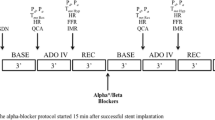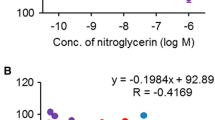Abstract
The effect of β-adrenergic blockade on coronary collateral blood flow has not been clarified. We examined the acute effects of β-adrenergic blockade on coronary collateral blood flow. Fifteen patients (Part A) with stable angina were studied while undergoing coronary angioplasty. According to the protocol, all patients underwent a minimum of three balloon inflations. Collateral flow velocity was determined during balloon inflations using the Doppler flow guidewire positioned distally to the lesion. The two tested balloon inflations, the second and third, were maintained for the same length of time. Between the second and third balloon inflations, 1 mg of propranolol was administered IC into the treated artery. Ten controls were studied following saline infusion. In 10 other patients (Part B), the effect of 1 mg IC propranolol on the coronary artery area distal to the lesion was studied, and five patients served as controls. In the treated group, in Part A blood pressure remained stable during the balloon inflations tested. Heart rate decreased from 79 ± 11 to 73 ± 12 beats/min (P < .05), velocity time integral from 9.6 ± 8.2 to 6.6 ± 4.1 cm (P < .05), and ST elevation from 1.3 ± .9 to .9 ± 1.0 mV (P < .05) between the second and third balloon inflations. In the controls the variables examined did not change during the balloon inflations tested. In Part B, neither propranolol nor normal saline had any significant effect on coronary artery lumen area. Thus, IC administration of β-adrenergic blockade decreases coronary collateral blood flow, and this potentially worsens the ischemic zone. However, β-adrenergic blockade ameliorates myocardial ischemia during coronary angioplasty.
Similar content being viewed by others
References
Holtz J, Saeed M, Sommer O, Bassenge E. Norepinephrine constricts the canine coronary bed via postsynaptic alpha2-adrenoreceptors. Eur J Pharmacol 1982;82:199-202.
Euler DE. Sympathetic influences on the native canine coronary collateral circulation. Cardiovasc Res 1995; 29:33-37.
Traverse JH, Altman JD, Kinn J, Duncker DJ, Bache RJ. Effect of β-adrenergic receptor blockade on blood flow to collateral-dependent myocardium during exercise. Circulation 1995;91:1560-1567.
Zmudka K, Aubert A, Dubiel J, Vanhaecke J, Flameng W, Kaczmarek J, Geest H. Early intravenous administration of metoprolol enhances myocardial salvage by thrombolysis with tissue-type plasminogen activator after thrombolytic coronary artery occlusion in the dog by improvement of the collateral blood flow to the area at risk. J Am Coll Cardiol 1994;23:1499-1504.
Doucette JW, Corl DP, Payne HP, et al. Validation of a Doppler guide wire for intravascular measurement of coronary artery flow velocity. Circulation 1992;85:1899-1911.
Yamada T, Okamoto M, Sueda T, Hashimoto M, Kajiyama G. Relation between collateral flow assessed by Doppler guide wire and angiographic collateral grades. Am Heart J 1995;130:32-37.
Kyriakides ZS, Kolettis TM, Sbarouni E, Antoniadis A, Giakoumakis T, Kremastinos DTh. Short-term atrioventricular sequential pacing does not adversely affect collateral blood flow. A study during angioplasty. PACE 1998; 21:706-713.
Uehata A, Matsuguchi T, Bittl JA, et al. Accuracy of electronic digital calipers compared with quantitative angiography in measuring coronary arterial diameter. Circulation 1993;88:724-729
Alfonso F, Macaya C, Goicolea J. Determinants of coronary compliance in patients with coronary artery disease: An intravascular ultrasound study. J Am Coll Cardiol 1994;23: 879-884.
Cribier A, Korsatz L, Koning R, Rath P, Gamra H, Stix G. Improved myocardial ischemic response and enhanced collateral circulation with long repetitive coronary occlusion during angioplasty: A prospective study. J Am Coll Cardiol 1992;20:578-586.
Quigley PJ, Hinohara T, Phillips HR, Peter RH, Behar VS, Kong K. Myocardial protection during coronary angioplasty with an autoperfusion balloon catheter in humans. Circulation 1988;78:1128-1134.
Kaltenbach M, Beyer J, Walter S, Klepzig H, Schmidts L. Prolonged application of pressure in transluminal coronary angioplasty. Cathet Cardiovasc Diagn 1984;10:213-219.
Perry RA, Seth A, Hunt A. Balloon occlusion during coronary angioplasty as a model ofmyocardial ischaemia: Reproducibility of sequential inflations. Eur Heart J 1989;10: 791-800.
Donohue TJ, Kern MJ, Aguire FV, Bell C, Penick D, Ofili E. Comparison of hemodynamic and pharmacologic perturbations of coronary collateral flow velocity in patients during angioplasty. J Am Coll Cardiol 1992;19:383A.
Takeuchi M, Nohtomi Y, Kuroiwa A. Does coronary flow assessed by blood flow velocity analysis reflect absolute coronary flow reserve? Cathet Cardiovasc Diagn 1996;38 251-254.
Hess OM, Bortone A, Gaglione A, Nonogi H, Grimm J, Krayenbuehl HP. Effect of intracoronary and intravenous propranolol on human coronary arteries. Eur Hear J 1989; 10:153-158.
Yock PG, Fitzgerald PJ, Sudhir K. Intravascular ultrasound. In: Topol E, ed. Textbook of Interventional Cardiology, 2nd ed. WB Saunders, Philadelphia: 1994:1136-1152.
Frisman WH. Multifactorial actions of beta-adrenergic blocking drugs in ischemic heart disease: Current concepts. Circulation 1983;67(Suppl I):I11-I18.
Murphee SS, Saffitz JE. Delineation of the distribution of b-adrenergic receptor subtypes in canine myocardium. Circ Res 1988;63:117-125.
Feldman RD, Christy JP, Paul ST, Harrison DG. β-adrenergic receptors on canine coronary collateral vessels: Characterisation and function. Am J Physiol 1989;257: H1634-H1639.
Lange R, Kloner RA, Braunwald E. First ultra-short-acting beta-adrenergic blocking agent: Its effect on size and segmental wall dynamics of reperfused myocardial infarct in dogs. Am J Cardiol 1983;51:1759-1767.
Rubio R, Berne R. Regulation of coronary blood flow. Prog Cardiovasc Dis 1975;18:105-122.
Harisson DG, Chilian WM, Marcus ML. Absence of functioning a-adrenergic receptors in mature canine coronary collaterals. Circ Res 1986;59:133-142.
DiCarlo JE, Blair RW, Bishop VS, Stone HL. Role of β2-adrenergic receptors on coronary resistance during exercise. J Appl Physiol 1988;64:2287-2293.
Author information
Authors and Affiliations
Rights and permissions
About this article
Cite this article
Kyriakides, Z.S., Kolettis, T., Antoniadis, A. et al. Beta-Adrenergic Blockade Decreases Coronary Collateral Blood Flow in Patients with Coronary Artery Disease. Cardiovasc Drugs Ther 12, 551–559 (1998). https://doi.org/10.1023/A:1007735320115
Issue Date:
DOI: https://doi.org/10.1023/A:1007735320115




